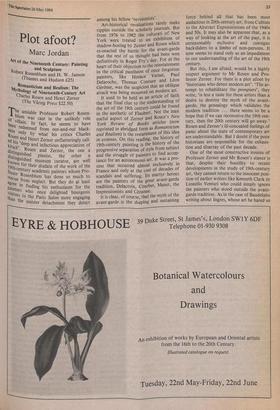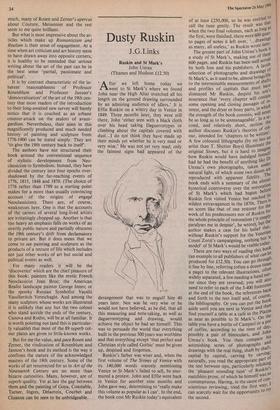Plot afoot?
Marc Jordan
Art of the Nineteenth Century: Painting and Sculpture Robert Rosenblum and H. W. Janson (Thames and Hudson £25) Romanticism and Realism: The Mythology of Nineteenth-Century Art Charles Rosen and Henri Zerner (The Viking Press $22.50)
The amiable Professor Robert Rosen- blum was cast in the unlikely role of villain. In fact, he seems to have been redeemed from out-and-out black- ness only by what his critics Charles .111,cisren and Henri Zerner unflatteringly call- '''. his 'deep and infectious appreciation of k!tsch,.
Rosen and Zerner, the one a ,distinguished pianist, the other a 'Istinguished museum curator, are well known for their disdain of the work of the glib-century academic painters whom Pro- lessor Rosenblum has done so much to rescue from neglect. But they do at least
agr.ee in finding his enthusiasm for the Painters who once delighted bourgeois visitors to the Paris Salon more engaging than
the sinister detachment they detect among his fellow 'revisionists'. Art-historical revaluations rarely make ripples outside the scholarly journals. But from 1976 to 1982 the culturati of New York were treated to an exhibition of shadow-boxing by Zerner and Rosen which re-enacted the battle for the avant-garde that the rest of us thought had been won definitively in Roger Fry's day. For at the heart of their objection to the reinstatement in the critical pantheon of once forgotten painters, like Horace Vernet, Paul Delaroche, Thomas Couture and Leon Gerome, was the suspicion that an oblique attack was being mounted on modern art.
It used to be held as an article of faith that the final clue to the understanding of the art of the 19th century could be found in the aesthetic of Flaubert. Not the least useful aspect of Zerner and Rosen's New York Review of Books articles (now reprinted in abridged form as Romanticism and Realism) is the restatement of this idea in extenso. On this reading, the history of 19th-century painting is the history of the progressive separation of style from subject and the struggle of painters to find accep- tance for an autonomous art. It was a pro- cess that occurred almost exclusively in France and only at the cost of decades of scandals and suffering. Its martyr heroes are the painters of the great avant-garde tradition, Delacroix, Courbet, Manet, the Impressionists and Cezanne.
It is clear, of course, that the myth of the avant-garde is the shaping and sustaining force behind all that has been most audacious in 20th-century art, from Cubism to the Abstract Expressionism of the 1940s and 50s. It may also be apparent that, as a way of looking at the art of the past, it is unreasonably exclusive and consigns backsliders to a limbo of non-persons. It now seems to stand only as an impediment to our understanding of the art of the 19th century.
But this, I am afraid, would be a highly suspect argument to Mr Rosen and Pro- fessor Zerner. For there is a plot afoot by `historians who detest modern art'. 'The at- tempt to rehabilitate the pompiers', they write, 'is less a taste for these artists than a desire to destroy the myth of the avant- garde, the genealogy which validates the modern tradition ... there seems to be a hope that if we can reconceive the 19th cen- tury, then the 20th century will go away.' Rosen and Zerner's ill-concealed feelings of panic about the state of contemporary art are understandable. But I doubt if the poor historians are responsible for the exhaus- tion and disarray of the past decade.
One of the most constructive ironies of Professor Zerner and Mr Rosen's stance is that, despite their hostility to recent developments in the study of 19th-century art, they cannot return to the innocent posi- tion of earlier writers like Kenneth Clark or Lionello Venturi who could simply ignore the painters who stood outside the avant- garde tradition. As in the case of Baudelaire writing about Ingres, whose art he hated so
much, many of Rosen and Zerner's apercus about Couture, Meissonier and the rest seem to me quite brilliant.
But what is most impressive about the ar- ticles which make up Romanticism and Realism is their sense of engagement. At a time when art criticism and art history seem to have drawn away into opposite corners, it is healthy to be reminded that serious writing about the art of the past can be in the best sense 'partial, passionate and political'.
It is by contrast characteristic of the in- herent reasonableness of Professor Rosenblum and Professor Janson's `democratisation' of the art of the 19th cen- tury that most readers of the introduction to their long-awaited new survey will barely notice that it is couched as an urbane counter-attack on the zealots of avant- gardism. Nevertheless, their aims in this magnificently produced and much needed history of painting and sculpture from 1776-1900 can be stated simply. They are 'to give the 19th century back to itself'.
The authors have not structured their book around the conventional sequence of stylistic development from Neo- classicism to Symbolism. Instead, they have divided the century into four epochs over- shadowed by the far-reaching events of 1776, 1815, 1848 and 1870. (The choice of 1776 rather than 1789 as a starting point makes for a more than usually convincing account of the origins of engage Neoclassicism). There are, of course, weaknesses here. One is that the accounts of the careers of several long-lived artists are irritatingly chopped up. Another is that too heavy an emphasis falls on works of an overtly public nature and partially obscures the 19th century's drift from declamatory to private art. But it does mean that we come to see painting and sculpture as the products of a texture of life which includes not just other works of art but social and political events as well.
For many readers it will be the 'discoveries' which are the chief pleasure of this book: painters like the erotic French Neoclassicist Jean Broc; the American Realist landscape painter George Innes; or the spooky Russian Symbolist Vassilii Vassilievitch Vereschagin. And among the many sculptors whose works are illustrated it is unlikely that any but the two colossi who stand astride the ends of the century, Canova and Rodin, will be at all familiar. It is worth pointing out (and this is particular- ly valuable) that most of the 89 superb col- our plates are given to little-known works.
But for me the value, and pace Rosen and Zerner, the vindication of Rosenblum and Janson's book and its method is the way it confirms the stature of the acknowledged masters of the 19th century. Some of the works of art resurrected for us in Art of the Nineteenth Century are no more than bizarre curiosities. Many, however, are of superb quality. Yet at last the gap between them and the painting of Goya, Constable, Turner, Ingres, Delacroix, Courbet and Cezanne can be seen to be unbridgeable.















































 Previous page
Previous page